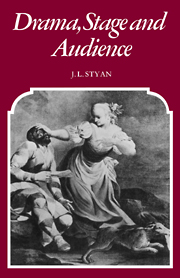Summary
Playhouse, script, actors, mise en scène, audience are inseparable parts of the theatre event. The concept of drama put forward in this book insists that the audience has an indispensable role to play. While Stanislavsky is right in saying that ‘spectators come to the theatre to hear the subtext. They can read the text at home’, he is speaking as a man of the nineteenth century. We do not go to the play merely to have the text interpreted and explained by the skills of the director and his actors. We do not go as in a learning situation, but to share in a partnership without which the players cannot work. In his Réflexions sur l'art, Valéry believed that ‘a creator is one who makes other create’: in art both the artist and the spectator actively cooperate, and the value of the work is dependent on this reciprocity.
If in the theatre there is no interaction between stage and audience, the play is dead, bad or non-existent: the audience, like the customer, is always right. Dramatic perception should be distinguished from the reading of a play as Susanne Langer distinguishes drama from literature:
Literature projects the image of life in the mode of virtual memory; language is its essential material; the sound and meaning of words, their familiar or unusual use and order, even their presentation on the printed page, create the illusion of life as a realm of events – completed, lived, as words formulate them – events that compose a Past. […]
- Type
- Chapter
- Information
- Drama Stage and Audience , pp. 224 - 241Publisher: Cambridge University PressPrint publication year: 1975



